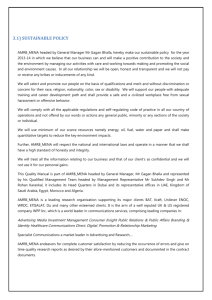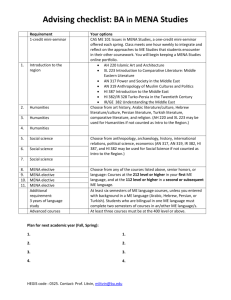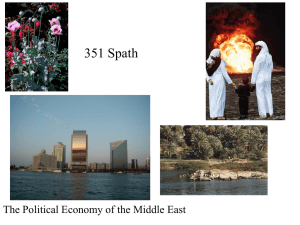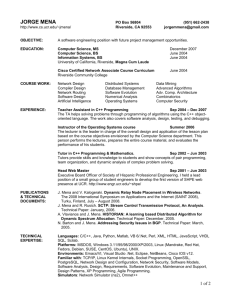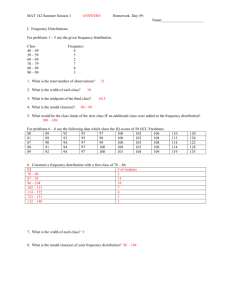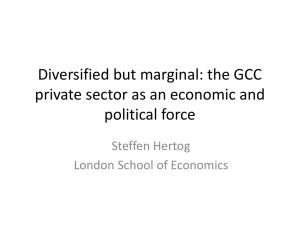Rethinking Economic Rentierism and Women's Empowerment
advertisement
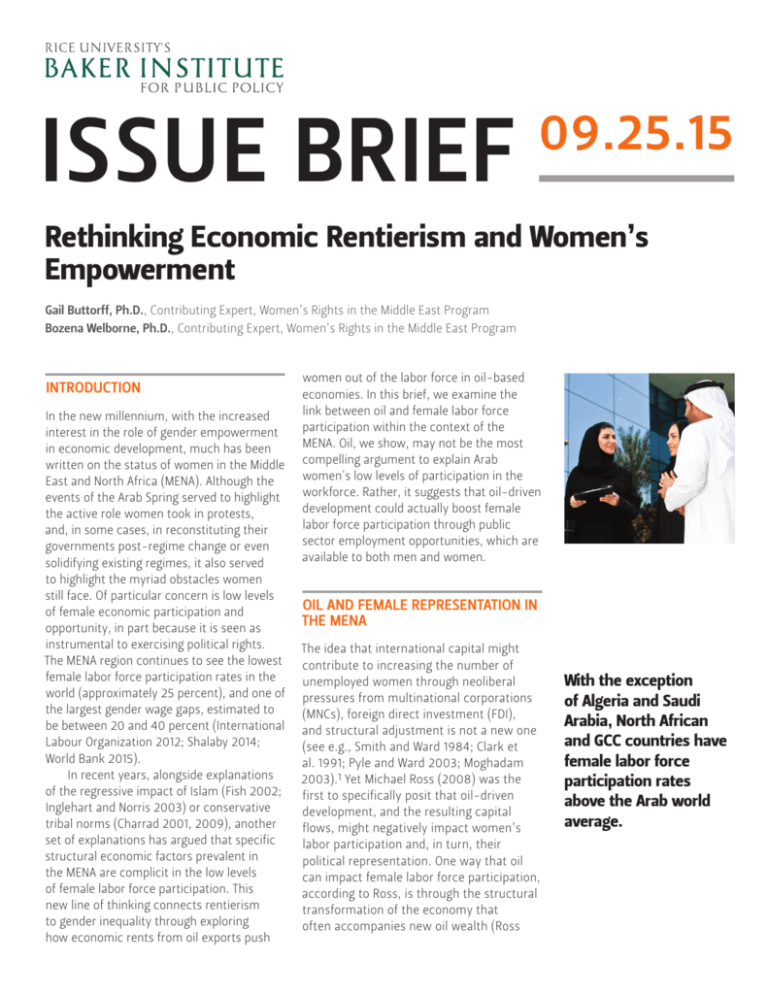
ISSUE BRIEF 09.25.15 Rethinking Economic Rentierism and Women’s Empowerment Gail Buttorff, Ph.D., Contributing Expert, Women’s Rights in the Middle East Program Bozena Welborne, Ph.D., Contributing Expert, Women’s Rights in the Middle East Program INTRODUCTION In the new millennium, with the increased interest in the role of gender empowerment in economic development, much has been written on the status of women in the Middle East and North Africa (MENA). Although the events of the Arab Spring served to highlight the active role women took in protests, and, in some cases, in reconstituting their governments post-regime change or even solidifying existing regimes, it also served to highlight the myriad obstacles women still face. Of particular concern is low levels of female economic participation and opportunity, in part because it is seen as instrumental to exercising political rights. The MENA region continues to see the lowest female labor force participation rates in the world (approximately 25 percent), and one of the largest gender wage gaps, estimated to be between 20 and 40 percent (International Labour Organization 2012; Shalaby 2014; World Bank 2015). In recent years, alongside explanations of the regressive impact of Islam (Fish 2002; Inglehart and Norris 2003) or conservative tribal norms (Charrad 2001, 2009), another set of explanations has argued that specific structural economic factors prevalent in the MENA are complicit in the low levels of female labor force participation. This new line of thinking connects rentierism to gender inequality through exploring how economic rents from oil exports push women out of the labor force in oil-based economies. In this brief, we examine the link between oil and female labor force participation within the context of the MENA. Oil, we show, may not be the most compelling argument to explain Arab women's low levels of participation in the workforce. Rather, it suggests that oil-driven development could actually boost female labor force participation through public sector employment opportunities, which are available to both men and women. OIL AND FEMALE REPRESENTATION IN THE MENA The idea that international capital might contribute to increasing the number of unemployed women through neoliberal pressures from multinational corporations (MNCs), foreign direct investment (FDI), and structural adjustment is not a new one (see e.g., Smith and Ward 1984; Clark et al. 1991; Pyle and Ward 2003; Moghadam 2003).1 Yet Michael Ross (2008) was the first to specifically posit that oil-driven development, and the resulting capital flows, might negatively impact women’s labor participation and, in turn, their political representation. One way that oil can impact female labor force participation, according to Ross, is through the structural transformation of the economy that often accompanies new oil wealth (Ross With the exception of Algeria and Saudi Arabia, North African and GCC countries have female labor force participation rates above the Arab world average. RICE UNIVERSITY’S BAKER INSTITUTE FOR PUBLIC POLICY // ISSUE BRIEF // 09.25.15 56.7 percent of women in the Middle East and 48 percent in North Africa were employed in the service sector in 2012. 2008, 109).2 More specifically, “Dutch Disease” makes countries possessing large natural resource wealth, such as gas or oil, experience a rise in their real exchange rate that over time results in deindustrialization or a move from traded sectors (e.g., manufacturing and agriculture) to nontraded sectors (e.g., services). Since women in developing contexts are disproportionately represented in the tradable sectors, this transformation of the economy has a gendered impact on female labor force participation. One of Ross’ primary hypotheses is that we should see lower female labor force participation in countries with a higher value of oil production (measured by oil rents per capita). Figures 1-3 show the female labor force participation rates for the Gulf Cooperation Council (GCC) states, North Africa, and the remaining MENA countries (excluding Israel). The dashed black line in each graph shows the average female labor force participation rate for all Arab countries. There are two key observations. First, with the exception of Algeria and Saudi Arabia, both the North African and GCC countries have female labor force participation rates above the Arab world average. We can also see this comparing Figures 1 and 2 with Figure 3: the GCC and North African countries have higher rates of female employment than in much of the remaining MENA countries, again with a few exceptions. Second, as Figure 1 reveals, four of the six GCC countries have seen labor participation rates above 30 percent for the past two decades, much higher than the Arab world average and higher than all four countries in North Africa. The fact that the GCC countries have some of the highest female labor force participation rates in the region suggests that the connection between oil and women's economic, and, ultimately political participation, is ambiguous at best in the MENA. RETHINKING THE LINK BETWEEN OIL AND FEMALE EMPLOYMENT FIGURE 1 — LABOR FORCE PARTICIPATION IN THE GCC, 1990-2013 SOURCE Data retrieved from “World Development Indicators 2015.” Available at http://databank. worldbank.org/data/reports.aspx?source=world-development-indicators#. 2 Why might we not be observing the relationship expected by Ross? One reason for the lack of a relationship may be that women’s employment in many MENA countries is not concentrated in the tradable sectors, which is a key assumption underlying the purported effect of oil on female labor force participation (Ross 2008, 110). Caraway (2009) notes that this assumption is at odds with women’s employment worldwide since women are a minority of workers in the manufacturing sector. The most recent report by the International Labour Organization (ILO) on global trends in women’s employment (2012) corroborates Caraway’s assertion (see Table 1). Table 1 reveals that, on average, women tend to work in the service sector across the region. In particular, 56.7 percent of women in the Middle East and 48 percent in North Africa were employed in the service sector. Comparatively, 36.2 percent of women in the Middle East were employed in agriculture and 11 percent in industry, while in North Africa some 40 percent of women were employed RETHINKING ECONOMIC RENTIERISM AND WOMEN’S EMPOWERMENT in agriculture and also 11 percent in industry. In fact, with the exclusion of Latin America (69.6 percent) and the OECD countries (75 percent), the MENA actually exhibits higher rates of female employment in the services compared to sub-Saharan Africa and Asia, and similar rates to those found in Eastern Europe. Essentially, working women in the MENA are not that different from their counterparts worldwide in terms of sector of employment. Recent work by Michael Herb differentiating between countries that are resource abundant (based on rents per capita) and resource dependent (based on rents as a percentage of GDP) offers a second, related explanation.3 Kuwait, Qatar, and the UAE have much higher rents per capita than the other three GCC countries, the distribution of which takes the form of public sector employment, by far the largest employer of citizens, rather than direct cash transfers. The so-called "extreme rentierism" of Kuwait, Qatar, and the UAE has afforded these GCC states the opportunity to hire 9 out of 10 willing citizens (Herb 2014, 2). Although Herb does not explicitly address the potential gendered impact of extreme rentierism, it has had an unintended positive effect on female labor force participation. From Figure 1 we can see that these three countries record the largest shares of females in the labor force, compared to other GCC countries and the rest of the MENA. The observed growth in labor force participation is,, notes Herb, “a direct consequence of female education, and especially female university education, which is, in turn, paid for by oil wealth” (2223). In both Qatar and the UAE, the average ratio of female to male tertiary enrollment between 1990 and 2013 was over 400 percent, and approximately 200 percent in Kuwait and Bahrain.4 These four countries lead the region in female enrollment in university by a wide margin. Oil wealth, however, could also directly benefit female labor force participation through the provision of public sector employment opportunities that can bypass limited private sector opportunities and/ or socio-cultural values that engender bias against women among private sector FIGURE 2 — FEMALE LABOR FORCE PARTICIPATION IN NORTH AFRICA, 1990-2013 SOURCE Data retrieved from “World Development Indicators 2015.” Available at http://databank. worldbank.org/data/reports.aspx?source=world-development-indicators#. FIGURE 3 — FEMALE LABOR FORCE PARTICIPATION IN THE REST OF THE MIDDLE EAST, 1990-2013 SOURCE Data retrieved from “World Development Indicators 2015.” Available at http://databank. worldbank.org/data/reports.aspx?source=world-development-indicators#. 3 RICE UNIVERSITY’S BAKER INSTITUTE FOR PUBLIC POLICY // ISSUE BRIEF // 09.25.15 TABLE 1 — FEMALE EMPLOYMENT SHARES BY ECONOMIC SECTOR Females Agriculture Industry Services 1992 2002 2012 1992 2002 2012 1992 2002 2012 World 48.4 43.2 36.4 15.7 14.7 16.2 35.4 42.1 47.4 Middle East 36.2 35.2 30.3 11.1 13.3 13.0 52.8 51.4 56.7 North Africa 40.6 26.4 31.8 11.4 12.7 11.2 48.0 60.9 57.0 Developed Economies and the European Union (OECD) 5.9 4.2 3.0 19.0 14.5 10.6 75.0 81.4 86.4 Central and South Eastern Europe (non-EU) and CIS 23.9 23 20.3 19.8 18.2 18.3 56.3 58.9 61.4 East Asia 65.6 55.5 39.0 18.7 18.0 24.8 15.7 26.5 36.2 South-East Asia and the Pacific 60.5 49.4 44.2 11.6 14.3 15.1 27.9 36.3 40.7 South Asia 77.0 71.9 68.9 11.8 13.1 15.4 11.3 15.0 15.8 Latin America and the Caribbean 16.2 11.9 9.0 14.2 14.2 13.3 69.6 73.9 77.7 Sub-Saharan Africa 70.8 66.3 62.5 5.6 6 6.3 23.6 27.7 31.2 SOURCE International Labour Organization, 2012. employers (though, of course, this may be true of the governments themselves). Therefore, another reason for the higher levels of female employment in Kuwait, Qatar, and the UAE, is public sector employment opportunities for women. Differentiating between resourcedependent and resource-abundant countries can also shed light on, and further explain, the variation between Iraq and Algeria on the one hand and the GCC countries on the other. Iraq and Algeria appear to better fit Ross’ expectations about the link between oil wealth and female labor force participation: both are resource-rich and have female labor force participation rates below the MENA average. These two countries are oil dependent, but not resource abundant. As a result, the governments do not have the ability to provide employment to a large proportion of the population, including women. 4 LOOKING AHEAD Female labor force participation appears to have benefitted from oil, and the public sector jobs used to distribute oil wealth, in the “extreme rentier” states of Kuwait, Qatar, and the UAE and to a lesser extent in the “middling rentier” states of Bahrain and Oman. One might argue GCC women have more employment opportunities precisely because there are so many service sector opportunities for them or because the rentier state in certain countries can also afford to co-opt everybody. It seems, therefore, that women have been able to find jobs despite oil-driven development, and perhaps even because of it. Ross and social scientists dating back to Friedrich Engels have argued that women's lack of labor force participation impacts a variety of social outcomes from fertility to women's educational attainment.5 RETHINKING ECONOMIC RENTIERISM AND WOMEN’S EMPOWERMENT Furthermore, he and others argue if women have less access to the broader world through work, women are also less likely to exchange ideas, less likely to politically mobilize, and ultimately less likely to call for political representation, leaving states bound in a culture of patriarchy. Current research explores how oil might impact female labor force participation, but we have less understanding of whether this will be a pathway to greater political empowerment in the MENA. In sum, Ross may be correct in maintaining that economic growth and different paths to development will impact women’s labor force participation; however, oil-driven development may not discourage and might even encourage women’s inclusion into the workforce as in the case of the resource abundant GCC states. ENDNOTES 1. Investment friendly environments limit budgetary spending, shrink taxes, and privatize government services while the conditionality associated with foreign aid often promotes neoliberal economic policies curtailing social programs that benefit and employ women (Acker 2004; Bergeron 2001). When public spending is cut, evidence shows women suffer disproportionately as they tend to be among the most vulnerable populations in developing societies (Bergeron 2001; Hemmati and Gardiner 2002; Rao and Kelleher 2005). 2. The second way oil, or Dutch Disease more generally, is expected to negatively affect female employment is through higher male wages and government transfers, which, in turn, increase household incomes and raise women’s reservation wages. 3. See Michael Herb, The Wages of Oil, especially pages 10-13. 4. See “World Development Indicators 2015.” Saudi Arabia and Oman reported averages of around 110 percent for the period. 5. See Iverson and Rosenbluth (2008) for an excellent review of the connection between economic and political empowerment. REFERENCES Acker, J. 2004. “Gender, capitalism and globalization.” Critical Sociology 30(1), 17-41. Bergeron, S. 2001. “Political economy discourses of globalization and feminist politics.” Signs: Journal of Women in Culture and Society 26(4): 983-1006. Caraway, T.L. 2009. “Comparative Political Economy, Gender, and Labor Markets.” Politics & Gender 5(4): 568-575. Charrad, Mounira. 2001. States and women's rights: The making of postcolonial Tunisia, Algeria, and Morocco. Berkely: University of California Press. Charrad, Mounira. 2009. “Kinship, Islam, or Oil: Culprits of Gender Inequality?” Politics & Gender 5(04): 546-553. Clark, R., T. W. Ramsbey, and E.S. Adler. 1991.“Culture, gender, and labor force participation: A cross-national study.” Gender and Society 5(1): 47-66. Fish, Steven. 2002. “Islam and Authoritarianism.” World Politics 55(1): 4-37. Hemmati, Minu, and Rosalie Gardiner. 2002. “Gender and Sustainable Development.” World Summit Papers of the Heinrich Boll Foundation. Germany: Heinrich Boll Foundation. Herb, Michael. 2014. The Wages of Oil: Parliaments and Economic Development in Kuwait and the UAE. Ithaca: Cornell University Press. International Labour Organization. 2012. “Global Employment Trends for Women Report.” Geneva: International Labour Office. Available at http://www.ilo.org/ wcmsp5/groups/public/---dgreports/--dcomm/documents/publication/ wcms_195447.pdf. Inglehart, Ronald and Pippa Norris. 2003. Rising Tide. New York: Cambridge University Press. Iversen, T., and F. Rosenbluth. 2008. “Work and Power: The Connection Between Female Labor Force Participation and Female Political Representation.” Annual Review of Political Science 11: 479-495. It seems that women have been able to find jobs despite oil-driven development, and perhaps even because of it. 5 RICE UNIVERSITY’S BAKER INSTITUTE FOR PUBLIC POLICY // ISSUE BRIEF // 09.25.15 See more issue briefs at: www.bakerinstitute.org/issue-briefs This publication was written by a researcher (or researchers) who participated in a Baker Institute project. Wherever feasible, this research is reviewed by outside experts before it is released. However, the views expressed herein are those of the individual author(s), and do not necessarily represent the views of Rice University’s Baker Institute for Public Policy. © 2015 Rice University’s Baker Institute for Public Policy This material may be quoted or reproduced without prior permission, provided appropriate credit is given to the author and Rice University’s Baker Institute for Public Policy. Cite as: Buttorff, Gail, Ph.D. and Bozena Welborne, Ph.D.. 2015. Rethinking Economic Rentierism and Women’s Empowerment. Issue brief no. 09.25.15. Rice University’s Baker Institute for Public Policy, Houston, Texas. 6 Moghadam, Valerie A. 2003. Modernizing Women: Gender and Social Change in the Middle East. Boulder, CO: Lynne Rienner Publishers. Pyle, J.L., and K.B. Ward. 2003. “Recasting our understanding of gender and work during global restructuring.” International Sociology 18(3): 461-489. Rao, A., and D. Kelleher. 2005. “Is there life after gender mainstreaming?” Gender & Development 13(2): 57-69. Ross, Michael. 2008. “Oil, Islam, and Women.” American Political Science Review 102: 1-22. Shalaby, Marwa. 2014. “The Paradox of Female Economic Participation in the Middle East and North Africa.” Issue Brief 03.07.2014. Rice University's Baker Institute, Houston, Texas. Smith, J.P., and M.P. Ward. 1984. Women's Wages and Work in the Twentieth Century. Santa Monica, CA: Rand Corporation. World Bank. “World Development Indicators 2015.” Washington, D.C.: World Bank. Available at http://databank.worldbank. org/data/reports.aspx?source=worlddevelopment-indicators. AUTHORS Gail Buttorff, Ph.D., is a contributing expert for the Women’s Rights in the Middle East Program at the Baker Institute and an assistant professor in the Department of Political Science at the University of Kansas. She currently teaches courses on Middle East and North African politics, Islam and politics, and quantitative research methods. Bozena Welborne, Ph.D., is a contributing expert for the Women's Rights in the Middle East Program at the Baker Institute and an assistant professor at Smith College. She currently teaches courses on Middle East politics, international political economy, comparative politics, global development and qualitative methods.

